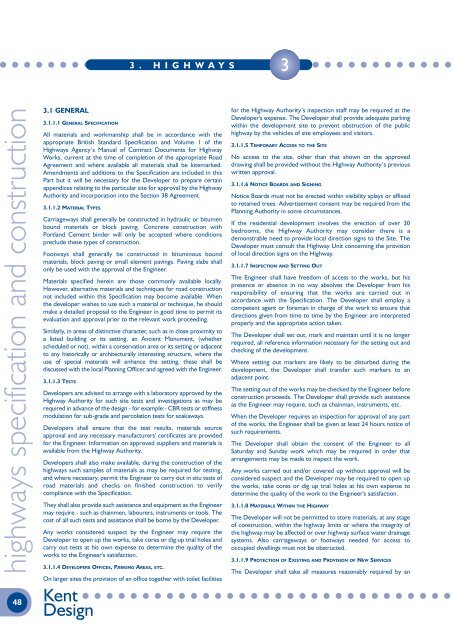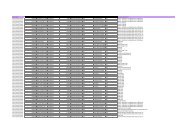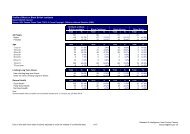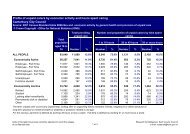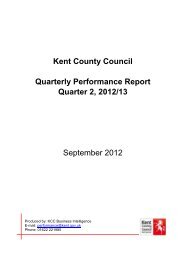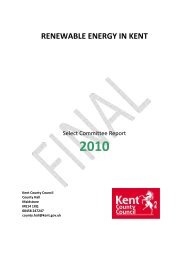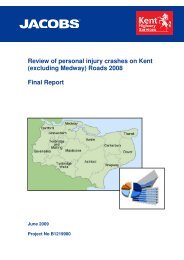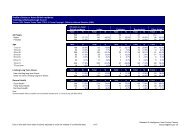Kent Design - Technical Appendix - Kent County Council
Kent Design - Technical Appendix - Kent County Council
Kent Design - Technical Appendix - Kent County Council
Create successful ePaper yourself
Turn your PDF publications into a flip-book with our unique Google optimized e-Paper software.
3. HIGHWAYS<br />
3<br />
highways specification and construction<br />
48<br />
3.1 GENERAL<br />
3.1.1.1 GENERAL SPECIFICATION<br />
All materials and workmanship shall be in accordance with the<br />
appropriate British Standard Specification and Volume 1 of the<br />
Highways Agency’s Manual of Contract Documents for Highway<br />
Works, current at the time of completion of the appropriate Road<br />
Agreement and where available all materials shall be kitemarked.<br />
Amendments and additions to the Specification are included in this<br />
Part but it will be necessary for the Developer to prepare certain<br />
appendices relating to the particular site for approval by the Highway<br />
Authority and incorporation into the Section 38 Agreement.<br />
3.1.1.2 MATERIAL TYPES<br />
Carriageways shall generally be constructed in hydraulic or bitumen<br />
bound materials or block paving. Concrete construction with<br />
Portland Cement binder will only be accepted where conditions<br />
preclude these types of construction.<br />
Footways shall generally be constructed in bituminous bound<br />
materials, block paving or small element pavings. Paving slabs shall<br />
only be used with the approval of the Engineer.<br />
Materials specified herein are those commonly available locally.<br />
However, alternative materials and techniques for road construction<br />
not included within this Specification may become available. When<br />
the developer wishes to use such a material or technique, he should<br />
make a detailed proposal to the Engineer in good time to permit its<br />
evaluation and approval prior to the relevant work proceeding.<br />
Similarly, in areas of distinctive character, such as in close proximity to<br />
a listed building or its setting, an Ancient Monument, (whether<br />
scheduled or not), within a conservation area or its setting or adjacent<br />
to any historically or architecturally interesting structure, where the<br />
use of special materials will enhance the setting, these shall be<br />
discussed with the local Planning Officer and agreed with the Engineer.<br />
3.1.1.3 TESTS<br />
Developers are advised to arrange with a laboratory approved by the<br />
Highway Authority for such site tests and investigations as may be<br />
required in advance of the design - for example:- CBR tests or stiffness<br />
modulation for sub-grade and percolation tests for soakaways.<br />
Developers shall ensure that the test results, materials source<br />
approval and any necessary manufacturers' certificates are provided<br />
for the Engineer. Information on approved suppliers and materials is<br />
available from the Highway Authority.<br />
Developers shall also make available, during the construction of the<br />
highways such samples of materials as may be required for testing,<br />
and where necessary, permit the Engineer to carry out in situ tests of<br />
road materials and checks on finished construction to verify<br />
compliance with the Specification.<br />
They shall also provide such assistance and equipment as the Engineer<br />
may require - such as chainmen, labourers, instruments or tools. The<br />
cost of all such tests and assistance shall be borne by the Developer.<br />
Any works considered suspect by the Engineer may require the<br />
Developer to open up the works, take cores or dig up trial holes and<br />
carry out tests at his own expense to determine the quality of the<br />
works to the Engineer's satisfaction.<br />
3.1.1.4 DEVELOPERS OFFICES, PARKING AREAS, ETC.<br />
On larger sites the provision of an office together with toilet facilities<br />
<strong>Kent</strong><br />
<strong>Design</strong><br />
for the Highway Authority’s inspection staff may be required at the<br />
Developer's expense. The Developer shall provide adequate parking<br />
within the development site to prevent obstruction of the public<br />
highway by the vehicles of site employees and visitors.<br />
3.1.1.5 TEMPORARY ACCESS TO THE SITE<br />
No access to the site, other than that shown on the approved<br />
drawing shall be provided without the Highway Authority’s previous<br />
written approval.<br />
3.1.1.6 NOTICE BOARDS AND SIGNING<br />
Notice Boards must not be erected within visibility splays or affixed<br />
to retained trees. Advertisement consent may be required from the<br />
Planning Authority in some circumstances.<br />
If the residential development involves the erection of over 30<br />
bedrooms, the Highway Authority may consider there is a<br />
demonstrable need to provide local direction signs to the Site. The<br />
Developer must consult the Highway Unit concerning the provision<br />
of local direction signs on the Highway.<br />
3.1.1.7 INSPECTION AND SETTING OUT<br />
The Engineer shall have freedom of access to the works, but his<br />
presence or absence in no way absolves the Developer from his<br />
responsibility of ensuring that the works are carried out in<br />
accordance with the Specification. The Developer shall employ a<br />
competent agent or foreman in charge of the work to ensure that<br />
directions given from time to time by the Engineer are interpreted<br />
properly and the appropriate action taken.<br />
The Developer shall set out, mark and maintain until it is no longer<br />
required, all reference information necessary for the setting out and<br />
checking of the development.<br />
Where setting out markers are likely to be disturbed during the<br />
development, the Developer shall transfer such markers to an<br />
adjacent point.<br />
The setting out of the works may be checked by the Engineer before<br />
construction proceeds. The Developer shall provide such assistance<br />
as the Engineer may require, such as chainman, instruments, etc.<br />
When the Developer requires an inspection for approval of any part<br />
of the works, the Engineer shall be given at least 24 hours notice of<br />
such requirements.<br />
The Developer shall obtain the consent of the Engineer to all<br />
Saturday and Sunday work which may be required in order that<br />
arrangements may be made to inspect the work.<br />
Any works carried out and/or covered up without approval will be<br />
considered suspect and the Developer may be required to open up<br />
the works, take cores or dig up trial holes at his own expense to<br />
determine the quality of the work to the Engineer's satisfaction.<br />
3.1.1.8 MATERIALS WITHIN THE HIGHWAY<br />
The Developer will not be permitted to store materials, at any stage<br />
of construction, within the highway limits or where the integrity of<br />
the highway may be affected or over highway surface water drainage<br />
systems. Also carriageways or footways needed for access to<br />
occupied dwellings must not be obstructed.<br />
3.1.1.9 PROTECTION OF EXISTING AND PROVISION OF NEW SERVICES<br />
The Developer shall take all measures reasonably required by an


